The Different Composition of Coumarins and Antibacterial Activity of Phlojodicarpus sibiricus and Phlojodicarpus villosus Root Extracts
Abstract
1. Introduction
2. Results
2.1. Coumarin Composition
2.2. Antibacterial Activity
3. Discussion
4. Materials and Methods
4.1. Object of Study
4.2. Analytical Chromatography and Mass Spectrometry
4.3. Photometric Bacteriostatic Test
4.4. Statistical Analysis
5. Conclusions
Supplementary Materials
Author Contributions
Funding
Data Availability Statement
Acknowledgments
Conflicts of Interest
References
- Kostova, I. Synthetic and natural coumarins as antioxidants. Mini-Rev. Med. Chem. 2006, 6, 365–374. [Google Scholar] [CrossRef]
- Basile, A.; Sorbo, S.; Spadaro, V.; Bruno, M.; Maggio, A.; Faraone, N.; Rosselli, S. Antimicrobial and Antioxidant Activities of Coumarins from the Roots of Ferulago campestris (Apiaceae). Molecules 2009, 14, 939–952. [Google Scholar] [CrossRef]
- Kayser, O.; Kolodziej, H. Antibacterial activity of simple coumarins: Structural requirements for biological activity. Z. Naturforschung C 1999, 54, 169–174. [Google Scholar] [CrossRef]
- Sancho, R.; Márquez, N.; Gómez-Gonzalo, M.; Calzado, M.A.; Bettoni, G.; Coiras, M.T.; Muñoz, E. Imperatorin inhibits HIV-1 replication through an Sp1-dependent pathway. J. Biol. Chem. 2004, 279, 37349–37359. [Google Scholar] [CrossRef] [PubMed]
- Shen, Y.F.; Liu, L.; Feng, C.Z.; Hu, Y.; Chen, C.; Wang, G.X.; Zhu, B. Synthesis and antiviral activity of a new coumarin derivative against spring viraemia of carp virus. Fish Shellfish Immunol. 2018, 81, 57–66. [Google Scholar] [CrossRef]
- Haziri, A.; Mazreku, I.; Rudhani, I. Anticoagulant activity of coumarin derivatives. Malays. Appl. Biol. 2022, 51, 107–109. [Google Scholar] [CrossRef]
- Kirsch, G.; Abdelwahab, A.B.; Chaimbault, P. Natural and Synthetic Coumarins with Effects on Inflammation. Molecules 2016, 21, 1322. [Google Scholar] [CrossRef] [PubMed]
- Hoult, J.R.S.; Payá, M. Pharmacological and biochemical actions of simple coumarins: Natural products with therapeutic potential. Gen. Pharmac. 1996, 27, 713–722. [Google Scholar] [CrossRef] [PubMed]
- Küpeli Akkol, E.; Genç, Y.; Karpuz, B.; Sobarzo-Sánchez, E.; Capasso, R. Coumarins and coumarin-related compounds in pharmacotherapy of cancer. Cancers 2020, 12, 1959. [Google Scholar] [CrossRef]
- Sharifi-Rad, J.; Cruz-Martins, N.; López-Jornet, P.; Lopez, E.P.F.; Harun, N.; Yeskaliyeva, B.; Beyatli, A.; Sytar, O.; Shaheen, S.; Sharopov, F.; et al. Natural coumarins: Exploring the pharmacological complexity and underlying molecular mechanisms. Oxid. Med. Cell. Longev. 2021, 6492346. [Google Scholar] [CrossRef]
- Stringlis, I.A.; De Jonge, R.; Pieterse, C.M. The age of coumarins in plant–microbe interactions. Plant Cell Physiol. 2019, 60, 1405–1419. [Google Scholar] [CrossRef] [PubMed]
- Río, J.A.; Diaz, L.; García-Bernal, D.; Blanquer, M.; Ortuño, A.; Correal, E.; Moraleda, M.J. Furanocoumarins: Biomolecules of Therapeutic Interest. In Studies in Natural Products Chemistry; Atta-ur-Rahman, Ed.; Elsevier Science: Amsterdam, The Netherlands, 2014; Volume 43, p. 30. [Google Scholar] [CrossRef]
- Khandy, M.T.; Sofronova, A.K.; Gorpenchenko, T.Y.; Chirikova, N.K. Plant Pyranocoumarins: Description, Biosynthesis, Application. Plants 2022, 11, 3135. [Google Scholar] [CrossRef]
- Smith, E.; Hosansky, N.; Bywater, W.G.; Tamelen, E.E. Constitution of Samidin, Dihydrosamidin and Visnadin. J. Am. Chem. Soc. 1956, 79, 3534–3540. [Google Scholar] [CrossRef]
- Murray, R.D.H. Naturally Occurring Plant Coumarins. In Fortschritte Der Chemie Organischer Naturstoffe/Progress in the Chemistry of Organic Natural Products; Springer: Berlin/Heidelberg, Germany, 1978; pp. 199–429. [Google Scholar] [CrossRef]
- Prachyawarakorn, V.; Mahidol, C.; Ruchirawat, S. Pyranocoumarins from the twigs of Mammea siamensis. Phytochemistry 2006, 67, 924–928. [Google Scholar] [CrossRef] [PubMed]
- Pimenov, M.G.; Ostroumova, T.A. Umbelliferae of Russia; KMK Scientific Publications Association: Moscow, Russia, 2012; 477p. (In Russia) [Google Scholar]
- Antonova, O.K.; Shemeryankin, B.V. Coumarins of the roots of Phlojodicarpus sibiricus. Chem. Nat. Compd. 1981, 17, 588. [Google Scholar] [CrossRef]
- Gantimur, D.; Syrchina, A.I.; Semenov, A.A. Khellactone derivatives from Phlojodicarpus sibiricus. Chem. Nat. Compd. 1986, 22, 103–104. [Google Scholar] [CrossRef]
- Nikonov, G.K.; Vandyshev, V.V. Visnadin—A new component of the plant genus Phlojodicarpus. Chem. Nat. Compd. 1969, 5, 101–102. [Google Scholar] [CrossRef]
- Babilev, F.V.; Nikonov, G.K. Coumarins of the roots of Phlojodicarpus villosus Turcz. Chem. Nat. Compd. 1965, 1, 278–279. [Google Scholar] [CrossRef]
- Olennikov, D.N.; Fedorov, I.A.; Kaschenko, N.I.; Chirikova, N.K.; Vennos, C. Khellactone Derivatives and Other Phenolics of Phlojodicarpus sibiricus (Apiaceae): HPLC-DAD-ESI-QQQ-MS/MS and HPLC-UV Profile, and Antiobesity Potential of Dihydrosamidin. Molecules 2019, 24, 2286. [Google Scholar] [CrossRef]
- Gulyaev, S.M. Protective action of Phlojodicarpus sibiricus in cerebral ischemia in rats. Bull. ESSC SB RAMS 2009, 3, 172–174. Available online: https://cyberleninka.ru/article/n/zaschitnoe-deystvie-phlojodicarpus-sibiricus-pri-ishemii-golovnogo-mozga-u-krys/viewer (accessed on 27 October 2023).
- Gulyaev, S.M.; Taraskin, V.V.; Radnaeva, L.D.; Nikolaev, S.M. Antiamnesic effect of Phlojodicarpus sibiricus extract in a scopolamine-induced amnesia model. Rev. Clin. Pharmacol. Drug Ther. 2017, 15, 53–57. Available online: https://cyberleninka.ru/article/n/antiamnesticheskiy-effekt-ekstrakta-vzdutoplodnika-sibirskogo-pri-skopolamin-indutsirovannoy-amnezii/viewer (accessed on 27 October 2023). [CrossRef][Green Version]
- Gulyaev, S.M.; Sandanov, T.M.; Markaryan, A.A. Pharmacotherapeutic effectiveness of the Phlojodicarpus sibiricus tincture under cerebral ischemia. Bashkortostan Med. J. 2009, 5, 33–37. Available online: https://cyberleninka.ru/article/n/farmakoterapevticheskaya-effektivnost-nastoyki-vzdutoplodnika-sibirskogo-pri-ishemii-golovnogo-mozga/viewer (accessed on 27 October 2023).
- Urbanova, E.Z.; Gulyaev, S.M.; Nikolaev, S.M.; Turtueva, T.A. Neuropharmacological effects of Phlojodicarpus sibiricus (Steph. ex Spreng.) K.-Pol. BSU Bull. 2013, 12, 125–128. Available online: https://www.bsu.ru/content/page/1454/mf2013.pdf#page=125 (accessed on 29 October 2023).
- Shurygin, A.Y.; Aseeva, T.A.; Skorokhod, N.S.; Abramova, N.O.; Gerasimenko, Y.G. Effect of ethanol extract of Phlojodicarpus sibiricus on neutritic growth of dorsal ganglia of chick embryos. Adv. Curr. Nat. Sci. 2005, 10, 90–91. Available online: https://s.natural-sciences.ru/pdf/2005/10/90.pdf (accessed on 25 October 2023).
- Lee, S.; Shin, D.S.; Kim, J.S.; Oh, K.B.; Kang, S.S. Antibacterial coumarins from Angelica gigas roots. Arch. Pharm. Res. 2003, 26, 449–452. [Google Scholar] [CrossRef] [PubMed]
- Souza, S.M.D.; Monache, F.D.; Smânia, A., Jr. Antibacterial activity of coumarins. Z. Naturforschung C 2005, 60, 693–700. [Google Scholar] [CrossRef] [PubMed]
- Qin, H.L.; Zhang, Z.W.; Ravindar, L.; Rakesh, K.P. Antibacterial activities with the structure-activity relationship of coumarin derivatives. Eur. J. Med. Chem. 2020, 207, 112832. [Google Scholar] [CrossRef] [PubMed]
- Valuyskikh, O.E.; Shadrin, D.M. Phylogenetic position of Phlojodicarpus villosus (Apiaceae) based on ITS and trnH-psbA nucleotide sequences. Turczaninowia 2021, 24, 12–22. [Google Scholar] [CrossRef]
- Gantimur, D.; Semenov, A.A. Coumarins of Phlojodicarpus villosus. Chem. Nat. Compd. 1984, 20, 362. [Google Scholar] [CrossRef]
- Tao, Y.; Luo, J.; Lu, Y.; Xu, D.; Hou, Z.; Kong, L. Rapid identification of two species of Peucedanum by high-performance liquid chromatography-diode array detection-electrospray ionization tandem mass spectrometry. Nat. Prod. Commun. 2009, 4, 1079–1084. [Google Scholar] [CrossRef]
- Shul’ts, E.E.; Ganbaatar, Z.; Petrova, T.N.; Shakirov, M.M.; Bagryanskaya, I.Y.; Taraskin, V.V.; Radnaeva, L.D.; Otgonsuren, D.; Pokrovskii, A.G.; Tolstikov, G.A. Plant coumarins. IX.* Phenolic compounds of Ferulopsis hystrix growing in Mongolia. Cytotoxic activity of 8,9-dihydrofurocoumarins. Chem. Nat. Compd. 2012, 48, 211–217. [Google Scholar] [CrossRef]
- Skalicka-Woźniak, K.; Mroczek, T.; Walasek, M.; Głowniak, K. Efficient isolation of dihydropyranocoumarins and simple coumarins from Mutellina purpurea fruits. Planta Medica 2016, 82, 1105–1109. [Google Scholar] [CrossRef]
- Yun, F.; Kang, A.; Shan, J.; Zhao, X.; Bi, X.; Di, L. A rapid and sensitive LC-MS/MS method for the determination of osthole in rat plasma: Application to pharmacokinetic study. Biomed. Chromatogr. 2013, 27, 676–680. [Google Scholar] [CrossRef]
- Razuvaeva, Y.G.; Toropova, A.A.; Salchak, S.M.; Olennikov, D.N. Coumarins of Ferulopsis hystrix: LC–MS Profiling and Gastroprotective and Antioxidant Activities of Skimmin and Peucenidin. Appl. Sci. 2023, 13, 9653. [Google Scholar] [CrossRef]
- Tine, Y.; Renucci, F.; Costa, J.; Wele, A.; Paolini, J. A Method for LC-MS/MS Profiling of Coumarins in Zanthoxylum zanthoxyloides (Lam.) B. Zepernich and Timler Extracts and Essential Oils. Molecules 2017, 22, 174. [Google Scholar] [CrossRef]
- Sigurdsson, S.; Jonsdottir, S.; Gudbjarnason, S. Geographical Variation of the Furanocoumarin Composition of the Fruits of Icelandic Angelica archangelica. Z. Naturforschung C 2012, 67, 1–7. [Google Scholar] [CrossRef] [PubMed]
- Burczyk, J.; Wierzchowska-Renke, K.; Głowniak, K.; Głowniak, P.; Marek, D. Geographic and environmental influences on the variation of essential oil and coumarins in Crithmum maritimum L. J. Herbs Spices Med. Plants 2002, 9, 305–311. [Google Scholar] [CrossRef]
- Brown, S.A. Biosynthesis of 6,7-dihydroxycoumarin in Cichorium intybus. Can. J. Biochem. Cell Biol. 1985, 63, 292–295. [Google Scholar] [CrossRef]
- Hamerski, D.; Matern, U. Elicitor-induced biosynthesis of psoralens in Ammi majus L. suspension cultures: Microsomal conversion of demethylsuberosin into (+) marmesin and psoralen. Eur. J. Biochem. 1988, 171, 369–375. [Google Scholar] [CrossRef]
- Bourgaud, F.; Hehn, A.; Larbat, R.; Doerper, S.; Gontier, E.; Kellner, S.; Matern, U. Biosynthesis of coumarins in plants: A major pathway still to be unravelled for cytochrome P450 enzymes. Phytochem. Rev. 2006, 5, 293–308. [Google Scholar] [CrossRef]
- Bayoumi, S.A.; Rowan, M.G.; Beeching, J.R.; Blagbrough, I.S. Investigation of biosynthetic pathways to hydroxycoumarins during post-harvest physiological deterioration in Cassava roots by using stable isotope labelling. ChemBioChem 2008, 9, 3013–3022. [Google Scholar] [CrossRef] [PubMed]
- Gomez-Robledo, H.B.; Cruz-Sosa, F.; Bernabé-Antonio, A.; Guerrero-Analco, A.; Olivares-Romero, J.B.; Alonso-Sánchez, A.; Villafan, E.; Ibarra-Laclette, E. Identification of candidate genes related to calanolide biosynthesis by transcriptome sequencing of Calophyllum brasiliense (Calophyllaceae). BMC Plant Biol. 2016, 16, 177. [Google Scholar] [CrossRef]
- Wang, P.; Fan, Z.; Wei, W.; Yang, C.; Wang, Y.; Shen, X.; Yan, X.; Zhou, Z. Biosynthesis of the Plant Coumarin Osthole by Engineered Saccharomyces cerevisiae. ACS Synth. Biol. 2023, 12, 2455–2462. [Google Scholar] [CrossRef] [PubMed]
- Rodrigues, J.L.; Rodrigues, L.R. Biosynthesis and heterologous production of furanocoumarins: Perspectives and current challenges. Nat. Prod. Rep. 2021, 38, 869–879. [Google Scholar] [CrossRef]
- Zou, Y.; Teng, Y.; Li, J.; Yan, Y. Recent advances in the biosynthesis of coumarin and its derivatives. Green Chem. Eng. 2023; in press. [Google Scholar] [CrossRef]
- He, B.-B.; Zhou, T.; Bu, X.-L.; Weng, J.-Y.; Xu, J.; Lin, S.; Zheng, J.-T.; Zhao, Y.-L.; Xu, M.J. Enzymatic pyran formation involved in xiamenmycin biosynthesis. ACS Catal. 2019, 9, 5391–5399. [Google Scholar] [CrossRef]
- Bu, X.-L.; He, B.-B.; Weng, J.-Y.; Jiang, C.-C.; Zhao, Y.-L.; Li, S.-M.; Xu, J.; Xu, M.-J. Constructing microbial hosts for the production of benzoheterocyclic derivatives. ACS Synth. Biol. 2020, 9, 2282–2290. [Google Scholar] [CrossRef] [PubMed]
- Karamat, F.; Olry, A.; Munakata, R.; Koeduka, T.; Sugiyama, A.; Paris, C.; Hehn, A.; Bourgaud, F.; Yazaki, K. A coumarin-specific prenyltransferase catalyzes the crucial biosynthetic reaction for furanocoumarin formation in parsley. Plant J. 2014, 77, 627–638. [Google Scholar] [CrossRef]
- Amaral, J.C.; da Silva, M.M.; da Silva, M.F.G.F.; Alves, T.C.; Ferreira, A.G.; Forim, M.R.; Fernandes, J.B.; Pina, E.S.; Lopes, A.A.; Pereira, A.M.S.; et al. Advances in the biosynthesis of pyranocoumarins: Isolation and 13C-incorporation analysis by high performance liquid chromatography-ultraviolet-solid-phase extraction-nuclear magnetic resonance data. J. Nat. Prod. 2020, 83, 1409–1415. [Google Scholar] [CrossRef]
- Sun, M.; Sun, M.; Zhang, J. Osthole: An overview of its sources, biological activities, and modification development. Med. Chem. Res. 2021, 30, 1767–1794. [Google Scholar] [CrossRef]
- Tan, N.; Yazıcı-Tütüniş, S.; Bilgin, M.; Tan, E.; Miski, M. Antibacterial Activities of Pyrenylated Coumarins from the Roots of Prangos hulusii. Molecules 2017, 22, 1098. [Google Scholar] [CrossRef]
- Venugopala, K.N.; Rashmi, V.; Odhav, B. Review on natural coumarin lead compounds for their pharmacological activity. BioMed Res. Int. 2013, 2013, 963248. [Google Scholar] [CrossRef] [PubMed]
- Yang, L.; Ding, W.; Xu, Y.; Wu, D.; Li, S.; Chen, J.; Guo, B. New Insights into the Antibacterial Activity of Hydroxycoumarins against Ralstonia solanacearum. Molecules 2016, 21, 468. [Google Scholar] [CrossRef] [PubMed]
- Alshibl, H.M.; Al-Abdullah, E.S.; Haiba, M.E.; Alkahtani, H.M.; Awad, G.E.A.; Mahmoud, A.H.; Ibrahim, B.M.M.; Bari, A.; Villinger, A. Synthesis and Evaluation of New Couamrin as Antioxidant, Antimicrobal, and Anti-Inflammatory Agents. Molecules 2020, 25, 3251. [Google Scholar] [CrossRef] [PubMed]
- Kim, S.M.; Lee, J.H.; Sethi, G.; Kim, C.; Baek, S.H.; Nam, D.; Chung, W.S.; Kim, S.-H.; Shim, B.S.; Ahn, K.S. Bergamottin, a natural furanocoumarin obtained from grapefruit juice induces chemosensitization and apoptosis through the inhibition of STAT3 signaling pathway in tumor cells. Cancer Lett. 2014, 354, 153–163. [Google Scholar] [CrossRef] [PubMed]
- Frérot, E.; Decorzant, E. Quantification of total furocoumarins in citrus oils by HPLC coupled with UV, fluorescence, and mass detection. J. Agric. Food Chem. 2004, 52, 6879–6886. [Google Scholar] [CrossRef] [PubMed]
- Wrzesniok, D.; Beberok, A.; Rok, J.; Delijewski, M.; Hechmann, A.; Oprzondek, M.; Rzepka, Z.; Bacler-Zbikowska, B.; Buszman, E. UVA radiation augments cytotoxic activity of psoralens in melanoma cells. Int. J. Radiat. Biol. 2017, 93, 734–739. [Google Scholar] [CrossRef] [PubMed]
- Atilla, E.; Atilla, P.A.; Bozdag, S.C.; Yuksel, M.K.; Toprak, S.K.; Topcuoglu, P.; Akay, B.N.; Sanli, H.; Akan, H.; Demirer, T.; et al. Extracorporeal photochemotherapy in mycosis fungoides. Transfus. Clin. Biol. 2017, 24, 454–457. [Google Scholar] [CrossRef]
- Bruni, R.; Barreca, D.; Protti, M.; Brighenti, V.; Righetti, L.; Anceschi, L.; Mercolini, L.; Benvenuti, S.; Gattuso, G.; Pellati, F. Botanical Sources, Chemistry, Analysis, and Biological Activity of Furanocoumarins of Pharmaceutical Interest. Molecules 2019, 24, 2163. [Google Scholar] [CrossRef]
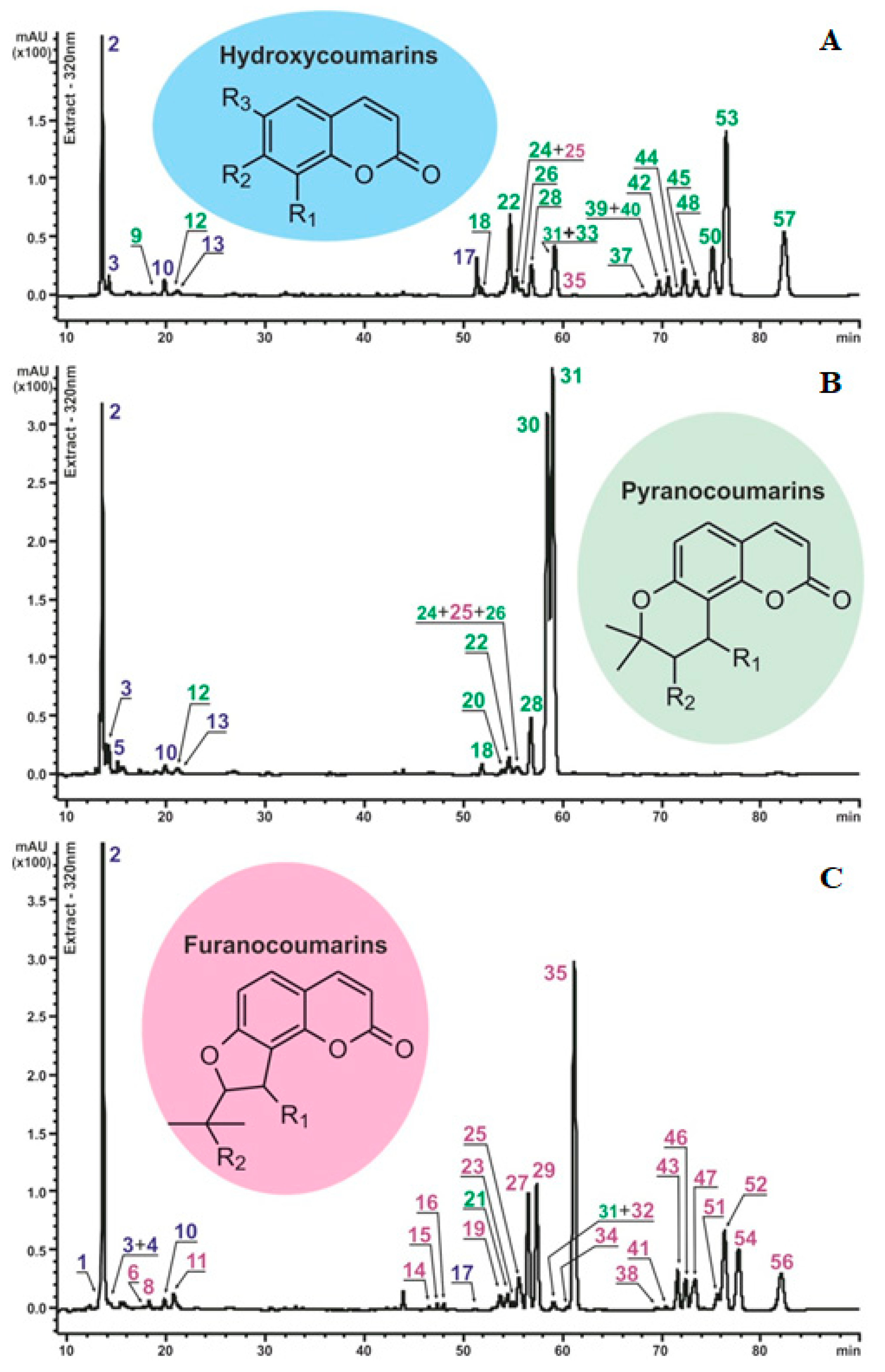
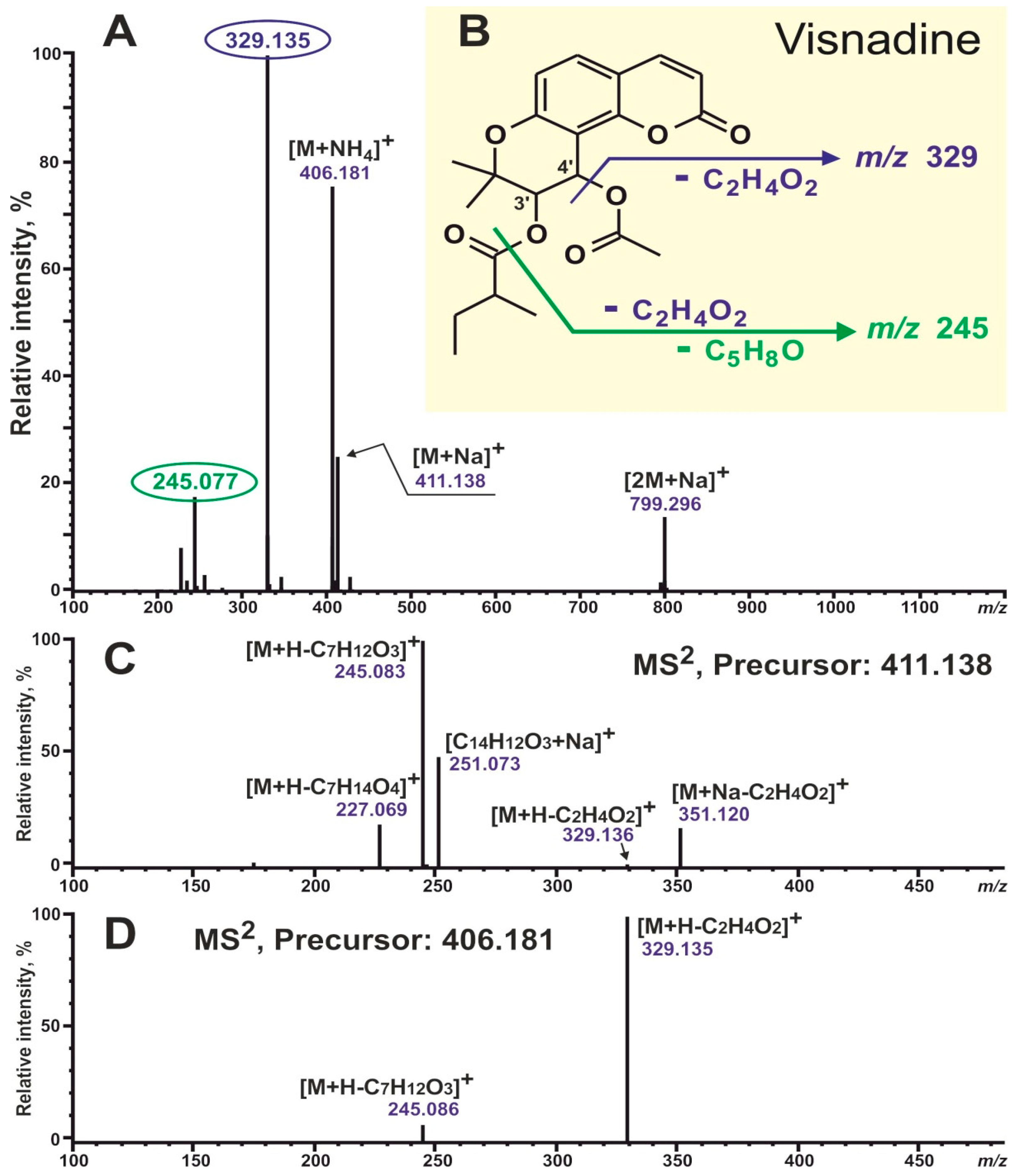
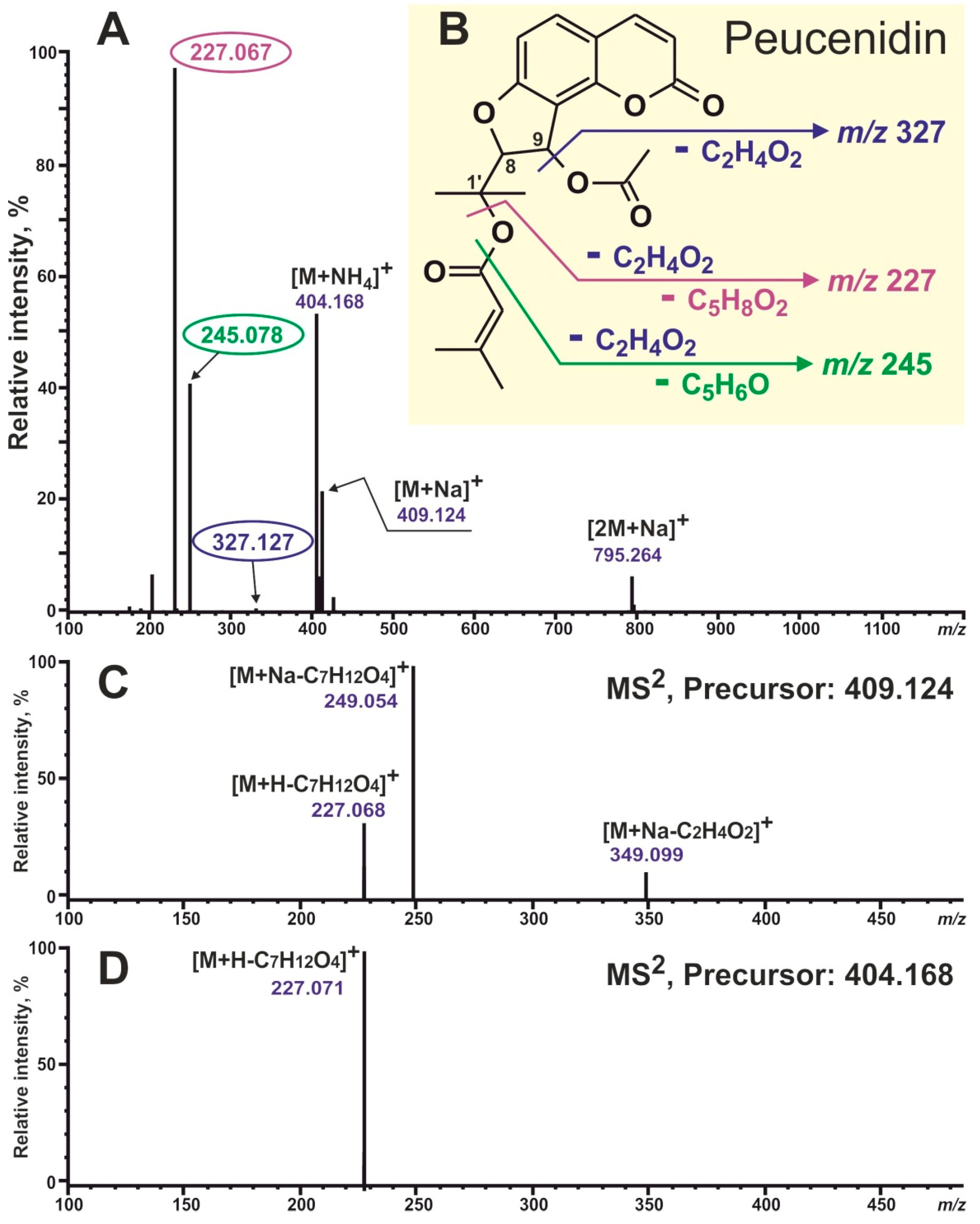
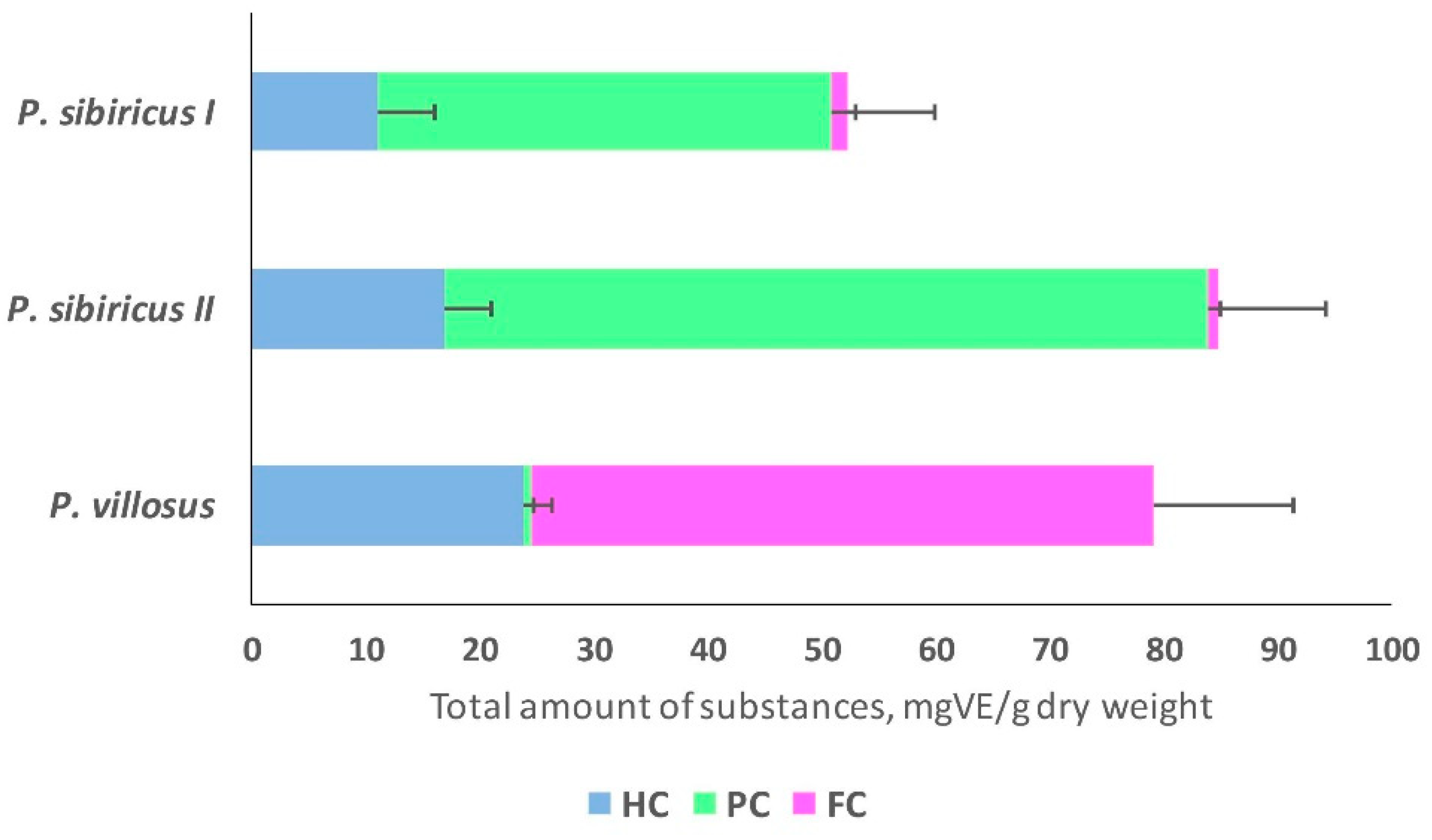

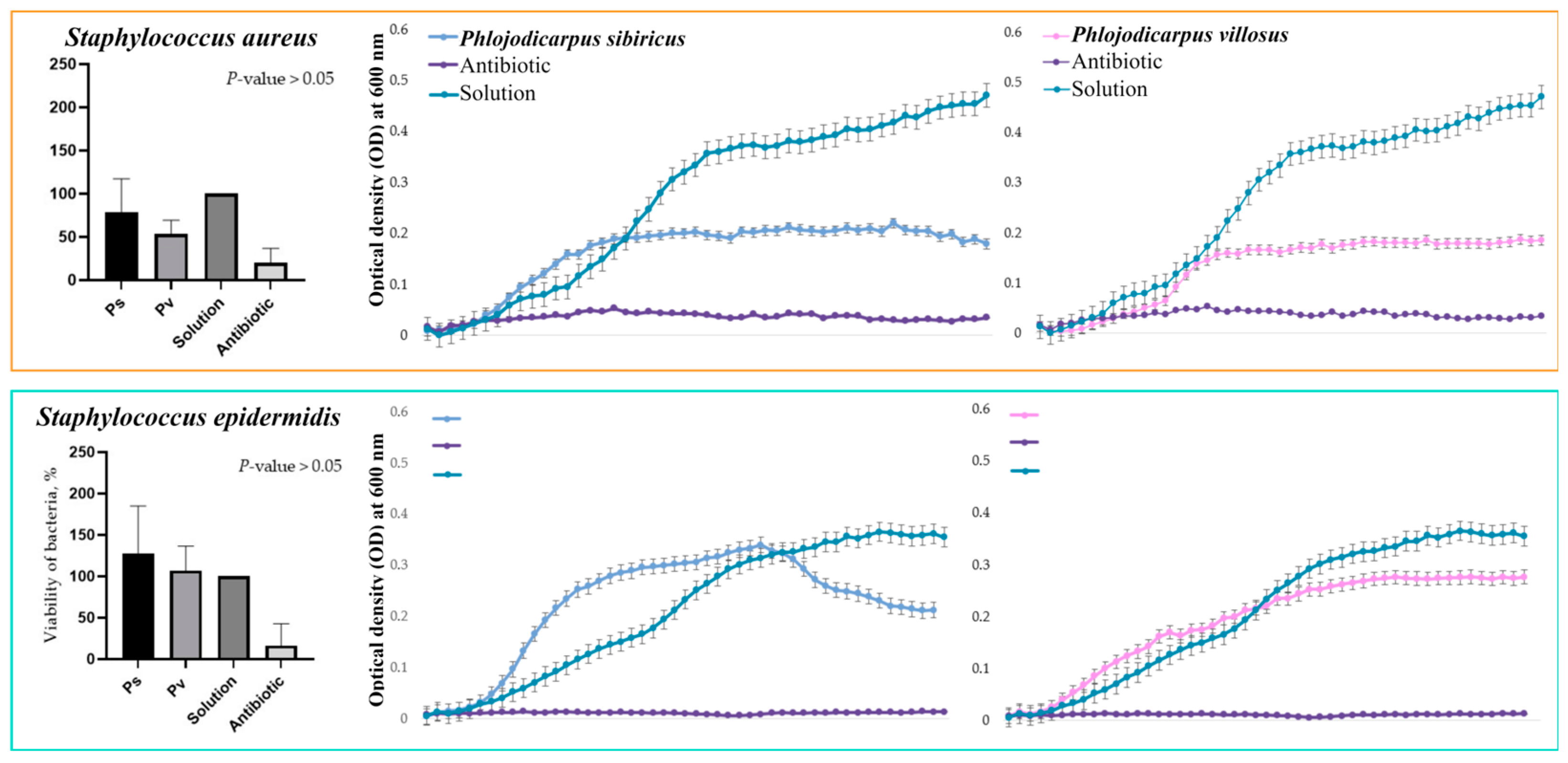
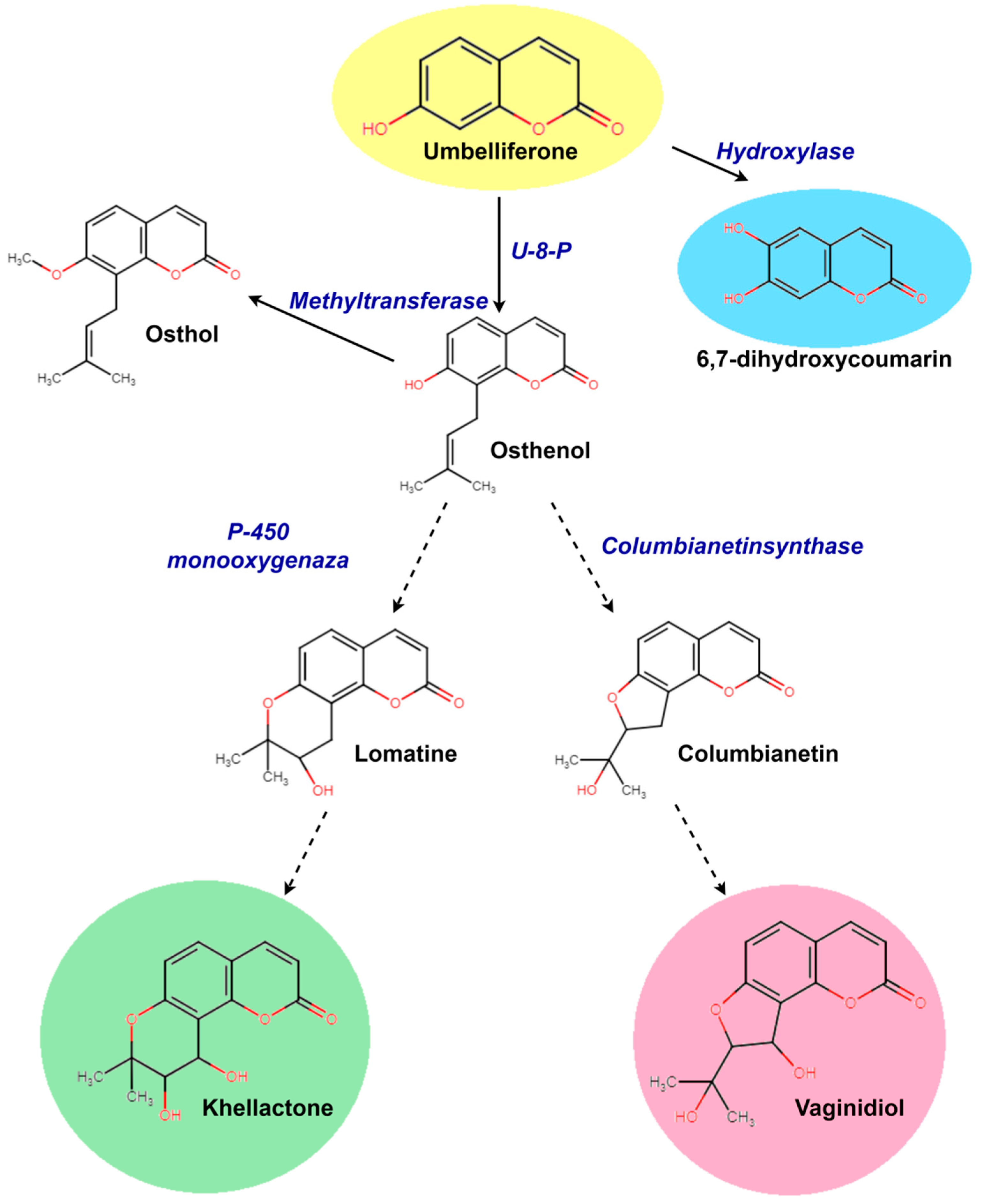
| No | TR, min | Compound 1 | UV max, nm | Molecular Formula (m.v.) | ESI-MS(MS2) Data, Main Diagnostic Ions | |
|---|---|---|---|---|---|---|
| Ion Composition (for MS2: all MS2 information is displayed in italics, Precursor Ion Composition is Shown in Parentheses) | m/z Values | |||||
| 1 | 13.2 | Umbelliferone-O-pentosyl-O-hexoside 2 | 317 | C20H24O12 (456) | [M+Na]+ | 479 |
| [M+H-C5H8O4]+ | 325 | |||||
| [M-H+Fa]− | 501 | |||||
| [M-H]− | 455 | |||||
| 2 | 13.6 | Umbelliferone-O-pentosyl-O-hexoside (Apiosylskimmin) 2 | 317 | C20H24O12 (456) | [M+Na]+ | 479 |
| [M+H-C5H8O4]+ | 325 | |||||
| [M+H-C5H8O4-C6H10O5]+ | 163 | |||||
| [M-H+Fa]− | 501 | |||||
| [M-H]− | 455 | |||||
| MS2([M-H]−): [M-H-C9H6O3]− | 293 | |||||
| 3 | 14.2 | Hydroxymethoxycoumarin-O-pentosyl-O-hexoside (Scopoletin-O-pentosyl-O-hexoside) 2 | 290, 332 | C21H26O13 (486) | [M+Na]+ | 509 |
| [M+H-C5H8O4]+ | 355 | |||||
| [M-H+Fa]− | 531 | |||||
| [M-H]− | 485 | |||||
| MS2([M-H]−): [M-H-C10H8O4]− | 293 | |||||
| 4 | 14.4 | Hydroxydimethoxycoumarin-O-pentosyl-O-hexoside (Fraxidin-O-pentosyl-O-hexoside) 2 | 288, 326 | C22H28O14 (516) | [M+Na]+ | 539 |
| [M-H+Fa]− | 561 | |||||
| [M-H]− | 515 | |||||
| MS2([M-H]−): [M-H-C11H18O9]− | 221 | |||||
| 5 | 15.1 | Peucedanol-O-pentosyl-O-hexoside 2 | 296, 325 | C25H34O14 (558) | [M+Na]+ | 581 |
| [M+H-C5H8O4]+ | 427 | |||||
| [M+H-C5H8O4-C6H10O5]+ | 265 | |||||
| [M-H+Fa]− | 603 | |||||
| [M-H]− | 557 | |||||
| MS2([M-H]−): [M-H-C11H18O9]− | 263 | |||||
| 6 | 17.7 | Vaginidiol-O-pentosyl-O-hexoside 2 | 329 | C25H32O14 (556) | [M+Na]+ | 579 |
| [M+H-C5H8O4-C6H10O5]+ | 263 | |||||
| [M-H+Fa]− | 601 | |||||
| [M-H]− | 555 | |||||
| 7 | 17.9 | Khellactone-O-pentosyl-O-hexoside 2 | nd | C25H32O14 (556) | [M+Na]+ | 579 |
| [M+H-C5H8O4-C6H10O5]+ | 263 | |||||
| [M-H+Fa]− | 601 | |||||
| [M-H]− | 555 | |||||
| 8 | 18.2 | Vaginidiol-O-hexoside 2 | 332 | C20H24O10 (424) | [M+Na]+ | 447 |
| [M+H-C5H8O4-C6H10O5]+ | 263 | |||||
| [M-H+Fa]− | 469 | |||||
| [M-H]− | 423 | |||||
| MS2([M+H-C5H8O4-C6H10O5]+): H2O loss | 245 | |||||
| MS2([M+H-C5H8O4-C6H10O5]+):2H2O loss | 227 | |||||
| 9 | 18.4 | Khellactone-O-hexoside 2 | 332 | C20H24O10 (424) | [M+Na]+ | 447 |
| [M+H-C5H8O4-C6H10O5]+ | 263 | |||||
| [M-H+Fa]− | 469 | |||||
| MS2([M+H-C5H8O4-C6H10O5]+): H2O loss | 245 | |||||
| 10 | 19.8 | Umbelliferone 2 | 324 | C9H6O3 (162) | [M+H]+ | 163 |
| 11 | 20.7 | Vaginidiol-O-hexoside 2 | 323 | C20H24O10 (424) | [2M+Na]+ | 871 |
| [M+Na]+ | 447 | |||||
| [M-H+Fa]− | 469 | |||||
| [M-H]− | 423 | |||||
| 12 | 21.0 | Khellactone-O-hexoside (Praeroside II) 2 | 324 | C20H24O10 (424) | [2M+Na]+ | 871 |
| [M+Na]+ | 447 | |||||
| [M-H+Fa]− | 469 | |||||
| [M-H]− | 423 | |||||
| 13 | 21.3 | Peucedanol-O-glucoside 2 | 326 | C20H26O10 (426) | [M+H]+ | 427 |
| [M+H-C6H10O5]+ | 265 | |||||
| [M-H]− | 425 | |||||
| 14 | 46.4 | Vaginidiol monoacyl ester 2 R1 or R2–C5H7O2 3 R2 or R1–OH | 323 | C19H20O6 (344) | [2M+Na]+ | 711 |
| [M+Na]+ | 367 | |||||
| [M+NH4]+ | 362 | |||||
| [M+H-C5H8O2]+ | 245 | |||||
| [M+H-C5H8O2-H2O]+ | 227 | |||||
| MS2([M+Na]+): [M+Na-C5H8O2]+ | 267 | |||||
| 15 | 47.3 | Vaginidiol monoacyl ester 2 R1 or R2–C5H7O2 3 R2 or R1–OH | 322 | C19H20O6 (344) | [2M+Na]+ | 711 |
| [M+Na]+ | 367 | |||||
| [M+NH4]+ | 362 | |||||
| [M+H-C5H8O2]+ | 245 | |||||
| [M+H-C5H8O2-H2O]+ | 227 | |||||
| MS2([M+Na]+): [M+Na-C5H8O2]+ | 267 | |||||
| 16 | 47.9 | Vaginidiol monoacyl ester 2 R1 or R2–C5H9O2 3 R2 or R1–OH | 326 | C19H22O6 (346) | [2M+Na]+ | 715 |
| [M+Na]+ | 369 | |||||
| [M+NH4]+ | 364 | |||||
| [M+H-C5H10O2]+ | 245 | |||||
| [M+H-C5H10O2-H2O]+ | 227 | |||||
| MS2([M+Na]+): [M+Na-C5H10O2]+ | 267 | |||||
| 17 | 51.3 | Methoxycoumarin prenylated (Osthole) 2 | 322 | C15H16O3 (244) | [M+H]+ | 245 |
| [M+H-C4H8]+ | 189 | |||||
| 18 | 51.8 | Khellactone diacyl ester 2 R1–C4H7O2 3 R2–C2H3O2 3 (Hyuganin D) 2 | 321 | C20H22O7 (374) | [2M+Na]+ | 771 |
| [M+Na]+ | 397 | |||||
| [M+NH4]+ | 392 | |||||
| [M+H-C4H8O2]+ | 287 | |||||
| [M+H-C4H8O2-C2H2O]+ | 245 | |||||
| 19 | 53.7 | Vaginidiol monoacyl ester 2 R1 or R2–C5H7O2 3 R2 or R1–H (Libanorin/Columbianadin) 2 | 328 | C19H20O5 (328) | [M-H]+ | 329 |
| [M+H-C5H8O2]+ | 229 | |||||
| 20 | 53.9 | Khellactone diacyl ester 2 R1–C2H3O2 3 R2–C5H7O2 3 | 323 | C21H22O7 (386) | [2M+Na]+ | 795 |
| [M+Na]+ | 409 | |||||
| [M+NH4]+ | 404 | |||||
| [M+H-C2H4O2]+ | 327 | |||||
| 21 | 54.4 | Khellactone diacyl ester 2 R1–C2H3O2 3 R2–C5H7O2 3 | 323 | C21H22O7 (386) | [2M+Na]+ | 795 |
| [M+Na]+ | 409 | |||||
| [M+NH4]+ | 404 | |||||
| [M+H-C2H4O2]+ | 327 | |||||
| 22 | 54.6 | Khellactone diacyl ester 2 R1–C5H7O2 3 R2–C2H3O2 3 (Pteryxin 2) | 322 | C21H22O7 (386) | [2M+Na]+ | 795 |
| [M+Na]+ | 409 | |||||
| [M+NH4]+ | 404 | |||||
| [M+H-C5H8O2]+ | 287 | |||||
| [M+H-C5H8O2-C2H2O]+ | 245 | |||||
| 23 | 54.9 | Vaginidiol diacyl ester 2 R1–C5H7O2 3 R2–C2H3O2 3 | 323 | C21H22O7 (386) | [2M+Na]+ | 795 |
| [M+Na]+ | 409 | |||||
| [M+NH4]+ | 404 | |||||
| [M+H-C5H8O2-C2H2O]+ | 245 | |||||
| [M+H-C5H8O2-C2H4O2]+ | 227 | |||||
| MS2([M+Na]+): [M+Na-C5H8O2]+ | 309 | |||||
| 24 | 55.3 | Khellactone monoacyl ester 2 R1 or R2–C5H7O2 3 R2 or R1–H (Lomatin-O-senecioyl ester) 2 | 325 | C19H20O5 328 | [M+Na]+ | 351 |
| [M+H]+ | 329 | |||||
| [M+H-C5H8O2]+ | 229 | |||||
| 25 | 55.5 | Vaginidiol diacyl ester 2 R1–C5H7O2 3 R2–C2H3O2 3 | 322 | C21H22O7 (386) | [2M+Na]+ | 795 |
| [M+Na]+ | 409 | |||||
| [M+NH4]+ | 404 | |||||
| [M+H-C5H8O2-C2H2O]+ | 245 | |||||
| [M+H-C5H8O2-C2H4O2]+ | 227 | |||||
| MS2([M+Na]+): [M+Na-C5H8O2]+ | 309 | |||||
| 26 | 55.9 | Khellactone diacyl ester 2 R1–C2H3O2 3 R2–C5H7O2 3 | 321 | C21H22O7 (386) | [2M+Na]+ | 795 |
| [M+Na]+ | 409 | |||||
| [M+NH4]+ | 404 | |||||
| [M+H-C2H4O2]+ | 327 | |||||
| 27 | 56.5 | Peucenidin 4 | 322 | C21H22O7 (386) | [2M+Na]+ | 795 |
| [M+Na]+ | 409 | |||||
| [M+NH4]+ | 404 | |||||
| [M+H-C5H6O-C2H4O2]+ | 245 | |||||
| [M+H-C5H8O2-C2H4O2]+ | 227 | |||||
| MS2([M+Na]+): [M+Na-C2H4O2]+ | 349 | |||||
| 28 | 56.8 | Khellactone monoacyl ester 2 R1 or R2–C5H9O2 3 R2 or R1–H (Lomatin-O-isovaleroyl ester) 2 | 325 | C19H22O5 (330) | [M+Na]+ | 353 |
| [M+H]+ | 331 | |||||
| [M+H-C5H10O2]+ | 229 | |||||
| 29 | 57.3 | Vaginidiol diacyl ester 2 R1–C5H7O2 3 R2–C2H3O2 3 (Libanotin) 2 | 322 | C21H22O7 (386) | [2M+Na]+ | 795 |
| [M+Na]+ | 409 | |||||
| [M+NH4]+ | 404 | |||||
| [M+H-C5H8O2-C2H4O]+ | 245 | |||||
| [M+H-C5H8O2-C2H4O2]+ | 227 | |||||
| MS2([M+Na]+): [M+Na-C5H8O2]+ | 309 | |||||
| 30 | 58.5 | Visnadin 4 | 323 | C21H24O7 (388) | [2M+Na]+ | 799 |
| [M+Na]+ | 411 | |||||
| [M+NH4]+ | 406 | |||||
| [M+H-C2H4O2]+ | 329 | |||||
| [M+H-C2H4O2-C5H8O]+ | 245 | |||||
| 31 | 59.0 | Khellactone diacyl ester 2 R1–C2H3O2 3 R2–C5H9O2 3 (Dihydrosamidin) 2 | 322 | C21H24O7 (388) | [2M+Na]+ | 799 |
| [M+Na]+ | 411 | |||||
| [M+NH4]+ | 406 | |||||
| [M+H-C2H4O2]+ | 329 | |||||
| [M+H-C2H4O2-C5H8O]+ | 245 | |||||
| 32 | 59.1 | Vaginidiol diacyl ester 2 R1–C2H3O2 3 R2–C5H9O2 3 | 319 | C21H24O7 (388) | [2M+Na]+ | 799 |
| [M+Na]+ | 411 | |||||
| [M+NH4]+ | 406 | |||||
| [M+H-C2H4O2-C5H8O]+ | 245 | |||||
| [M+H-C5H10O2-C2H4O2]+ | 227 | |||||
| MS2([M+Na]+): [M+Na-C2H4O2]+ | 351 | |||||
| 33 | 59.2 | Khellactone diacyl ester 2 R1–C5H9O2 3 R2–C2H3O2 3 (Suksdorfin) 2 | 322 | C21H24O7 (388) | [2M+Na]+ | 799 |
| [M+Na]+ | 411 | |||||
| [M+NH4]+ | 406 | |||||
| [M+H-C5H10O2]+ | 287 | |||||
| [M+H-C2H2O-C5H10O2]+ | 245 | |||||
| 34 | 60.4 | Vaginidiol diacyl ester 2 R1–C2H3O2 3 R2–C5H9O2 3 | 323 | C21H24O7 (388) | [2M+Na]+ | 799 |
| [M+Na]+ | 411 | |||||
| [M+NH4]+ | 406 | |||||
| [M+H-C2H4O2-C5H8O]+ | 245 | |||||
| [M+H-C5H10O2-C2H4O2]+ | 227 | |||||
| MS2([M+Na]+): [M+Na-C2H4O2]+ | 351 | |||||
| 35 | 61.1 | Vaginidiol diacyl ester 2 R1–C2H3O2 3 R2–C5H9O2 3 | 321 | C21H24O7 (388) | [2M+Na]+ | 799 |
| [M+Na]+ | 411 | |||||
| [M+NH4]+ | 406 | |||||
| [M+H-C2H4O2-C5H8O]+ | 245 | |||||
| [M+H-C5H10O2-C2H4O2]+ | 227 | |||||
| MS2([M+Na]+): [M+Na-C2H4O2]+ | 351 | |||||
| 36 | 61.1 | Khellactone diacyl ester 2 R1–C2H3O2 3 R2–C5H9O2 3 | 323 | C21H24O7 (388) | [2M+Na]+ | 799 |
| [M+Na]+ | 411 | |||||
| [M+NH4]+ | 406 | |||||
| [M+H-C2H4O2]+ | 329 | |||||
| [M+H-C2H4O2-C5H8O]+ | 245 | |||||
| 37 | 68.3 | Khellactone diacyl ester 2 R1–C4H7O2 3 R2–C5H7O2 3 | 320 | C23H26O7 (414) | [2M+Na]+ | 851 |
| [M+Na]+ | 437 | |||||
| [M+NH4]+ | 432 | |||||
| [M+H-C4H8O2]+ | 327 | |||||
| 38 | 69.4 | Vaginidiol diacyl ester 2 R1–C4H7O2 3 R2–C5H7O2 3 together with R1–C5H7O2 3 R2–C4H7O2 3 | 321 | C23H26O7 (414) | [2M+Na]+ | 851 |
| [M+Na]+ | 437 | |||||
| [M+NH4]+ | 432 | |||||
| [M+H-C4H8O2-C5H6O]+ | 245 | |||||
| [M+H-C4H8O2-C5H8O2]+ | 227 | |||||
| MS2([M+Na]+): [M+Na-C4H8O2]+ | 349 | |||||
| MS2([M+Na]+): [M+Na-C5H8O2]+ | 337 | |||||
| 39 | 69.7 | Khellactone diacyl ester 2 R1–C4H7O2 3 R2–C5H7O2 3 | 320 | C23H26O7 (414) | [2M+Na]+ | 851 |
| [M+Na]+ | 437 | |||||
| [M+NH4]+ | 432 | |||||
| [M+H-C4H8O2]+ | 327 | |||||
| 40 | 69.7 | Khellactone diacyl ester 2 R1–C5H7O2 3 R2–C5H7O2 3 | 323 | C24H26O7 (426) | [2M+Na]+ | 875 |
| [M+Na]+ | 449 | |||||
| [M+NH4]+ | 444 | |||||
| [M+H-C5H8O2]+ | 327 | |||||
| 41 | 70.4 | Vaginidiol diacyl ester 2 R1–C5H7O2 3 R2–C4H7O2 3 | 320 | C23H26O7 (414) | [2M+Na]+ | 851 |
| [M+Na]+ | 437 | |||||
| [M+H-C5H8O2-C4H6O]+ | 245 | |||||
| [M+H-C4H8O2-C5H8O2]+ | 227 | |||||
| MS2([M+Na]+): [M+Na-C5H8O2]+ | 337 | |||||
| 42 | 70.6 | Khellactone diacyl ester 2 R1–C5H7O2 3 R2–C5H7O2 3 | 322 | C24H26O7 (426) | [2M+Na]+ | 875 |
| [M+Na]+ | 449 | |||||
| [M+NH4]+ | 444 | |||||
| [M+H-C5H8O2]+ | 327 | |||||
| 43 | 71.5 | Vaginidiol diacyl ester 2 R1–C5H7O2 3 R2–C5H7O2 3 | 321 | C24H26O7 (426) | [2M+Na]+ | 875 |
| [M+Na]+ | 449 | |||||
| [M+NH4]+ | 444 | |||||
| [M+H-C5H8O2-C5H6O]+ | 245 | |||||
| [M+H-C5H8O2-C5H8O2]+ | 227 | |||||
| MS2([M+Na]+): [M+Na-C5H8O2]+ | 349 | |||||
| 44 | 71.6 | Khellactone diacyl ester 2 R1–C5H7O2 3 R2–C5H7O2 3 | 322 | C24H26O7 (426) | [2M+Na]+ | 875 |
| [M+Na]+ | 449 | |||||
| [M+NH4]+ | 444 | |||||
| [M+H-C5H8O2]+ | 327 | |||||
| 45 | 72.2 | Khellactone diacyl ester 2 R1–C5H7O2 3 R2–C5H7O2 3 (Pracruptorin D) 2 | 321 | C24H26O7 (426) | [2M+Na]+ | 875 |
| [M+Na]+ | 449 | |||||
| [M+NH4]+ | 444 | |||||
| [M+H-C5H8O2]+ | 327 | |||||
| 46 | 72.4 | Vaginidiol diacyl ester 2 R1–C5H7O2 3 R2–C5H7O2 3 | 322 | C24H26O7 (426) | [2M+Na]+ | 875 |
| [M+Na]+ | 449 | |||||
| [M+NH4]+ | 444 | |||||
| [M+H-C5H8O2-C5H6O]+ | 245 | |||||
| [M+H-C5H8O2-C5H8O2]+ | 227 | |||||
| MS2([M+Na]+): [M+Na-C5H8O2]+ | 349 | |||||
| 47 | 73.3 | Vaginidiol diacyl ester 2 R1–C5H7O2 3 R2–C5H7O2 3 | 322 | C24H26O7 (426) | [2M+Na]+ | 875 |
| [M+Na]+ | 449 | |||||
| [M+NH4]+ | 444 | |||||
| [M+H-C5H8O2-C5H6O]+ | 245 | |||||
| [M+H-C5H8O2-C5H8O2]+ | 227 | |||||
| MS2([M+Na]+): [M+Na-C5H8O2]+ | 349 | |||||
| 48 | 73.4 | Khellactone diacyl ester 2 R1–C4H7O2 3 R2–C5H9O2 3 | 321 | C23H28O7 (416) | [2M+Na]+ | 855 |
| [M+Na]+ | 439 | |||||
| [M+NH4]+ | 434 | |||||
| [M+H-C4H8O2]+ | 329 | |||||
| 49 | 74.2 | Vaginidiol diacyl ester 2 R1–C4H7O2 3 R2–C5H9O2 3 | 323 | C23H28O7 (416) | [2M+Na]+ | 855 |
| [M+Na]+ | 439 | |||||
| [M+NH4]+ | 434 | |||||
| [M+H-C4H8O2-C5H8O]+ | 245 | |||||
| [M+H-C4H8O2-C5H10O2]+ | 227 | |||||
| MS2([M+Na]+): [M+Na-C4H8O2]+ | 351 | |||||
| 50 | 75.1 | Khellactone diacyl ester 2 R1–C5H7O2 3 R2–C5H9O2 3 | 323 | C24H28O7 (428) | [2M+Na]+ | 879 |
| [M+Na]+ | 451 | |||||
| [M+NH4]+ | 446 | |||||
| [M+H-C5H8O2]+ | 329 | |||||
| 51 | 75.6 | Vaginidiol diacyl ester 2 R1–C5H9O2 3 R2–C5H7O2 3 | 321 | C24H28O7 (428) | [2M+Na]+ | 879 |
| [M+Na]+ | 451 | |||||
| [M+NH4]+ | 446 | |||||
| [M+H-C5H10O2-C5H6O]+ | 245 | |||||
| [M+H-C5H10O2-C5H8O2]+ | 227 | |||||
| MS2([M+Na]+): [M+Na-C5H10O2]+ | 349 | |||||
| 52 | 76.3 | Vaginidiol diacyl ester 2 R1–C5H7O2 3 R2–C5H9O2 3 | 322 | C24H28O7 (428) | [2M+Na]+ | 879 |
| [M+Na]+ | 451 | |||||
| [M+NH4]+ | 446 | |||||
| [M+H-C5H8O2-C5H8O]+ | 245 | |||||
| [M+H-C5H8O2-C5H10O2]+ | 227 | |||||
| MS2([M+Na]+): [M+Na-C5H8O2]+ | 351 | |||||
| 53 | 76.5 | Khellactone diacyl ester 2 R1–C5H7O2 3 R2–C5H9O2 3 | 323 | C24H28O7 (428) | [2M+Na]+ | 879 |
| [M+Na]+ | 451 | |||||
| [M+NH4]+ | 446 | |||||
| [M+H-C5H8O2]+ | 329 | |||||
| [M+H-C5H8O2-C5H8O]+ | 245 | |||||
| 54 | 77.7 | Vaginidiol diacyl ester 2 R1–C5H7O23 R2–C5H9O23 | 320 | C24H28O7 (428) | [2M+Na]+ | 879 |
| [M+Na]+ | 451 | |||||
| [M+NH4]+ | 446 | |||||
| [M+H-C5H8O2-C5H8O]+ | 245 | |||||
| [M+H-C5H8O2-C5H10O2]+ | 227 | |||||
| MS2([M+Na]+): [M+Na-C5H8O2]+ | 351 | |||||
| 55 | 81.9 | Khellactone diacyl ester 2 R1–C5H9O2 3 R2–C5H9O2 3 | 322 | C24H30O7 (430) | [2M+Na]+ | 883 |
| [M+Na]+ | 453 | |||||
| [M+NH4]+ | 448 | |||||
| [M+H-C5H10O2]+ | 329 | |||||
| 56 | 82.0 | Vaginidiol diacyl ester 2 R1–C5H9O2 3 R2–C5H9O2 3 | 322 | C24H30O7 (430) | [2M+Na]+ | 883 |
| [M+Na]+ | 453 | |||||
| [M+H-C5H8O2-C5H8O]+ | 245 | |||||
| [M+H-C5H8O2-C5H10O2]+ | 227 | |||||
| MS2([M+Na]+): [M+Na-C5H8O2]+ | 351 | |||||
| 57 | 82.3 | Khellactone diacyl ester 2 R1–C5H9O2 3 R2–C5H9O2 3 | 322 | C24H30O7 (430) | [2M+Na]+ | 883 |
| [M+Na]+ | 453 | |||||
| [M+NH4]+ | 448 | |||||
| [M+H-C5H10O2]+ | 329 | |||||
Disclaimer/Publisher’s Note: The statements, opinions and data contained in all publications are solely those of the individual author(s) and contributor(s) and not of MDPI and/or the editor(s). MDPI and/or the editor(s) disclaim responsibility for any injury to people or property resulting from any ideas, methods, instructions or products referred to in the content. |
© 2024 by the authors. Licensee MDPI, Basel, Switzerland. This article is an open access article distributed under the terms and conditions of the Creative Commons Attribution (CC BY) license (https://creativecommons.org/licenses/by/4.0/).
Share and Cite
Khandy, M.T.; Grigorchuk, V.P.; Sofronova, A.K.; Gorpenchenko, T.Y. The Different Composition of Coumarins and Antibacterial Activity of Phlojodicarpus sibiricus and Phlojodicarpus villosus Root Extracts. Plants 2024, 13, 601. https://doi.org/10.3390/plants13050601
Khandy MT, Grigorchuk VP, Sofronova AK, Gorpenchenko TY. The Different Composition of Coumarins and Antibacterial Activity of Phlojodicarpus sibiricus and Phlojodicarpus villosus Root Extracts. Plants. 2024; 13(5):601. https://doi.org/10.3390/plants13050601
Chicago/Turabian StyleKhandy, Maria T., Valeria P. Grigorchuk, Anastasia K. Sofronova, and Tatiana Y. Gorpenchenko. 2024. "The Different Composition of Coumarins and Antibacterial Activity of Phlojodicarpus sibiricus and Phlojodicarpus villosus Root Extracts" Plants 13, no. 5: 601. https://doi.org/10.3390/plants13050601
APA StyleKhandy, M. T., Grigorchuk, V. P., Sofronova, A. K., & Gorpenchenko, T. Y. (2024). The Different Composition of Coumarins and Antibacterial Activity of Phlojodicarpus sibiricus and Phlojodicarpus villosus Root Extracts. Plants, 13(5), 601. https://doi.org/10.3390/plants13050601







